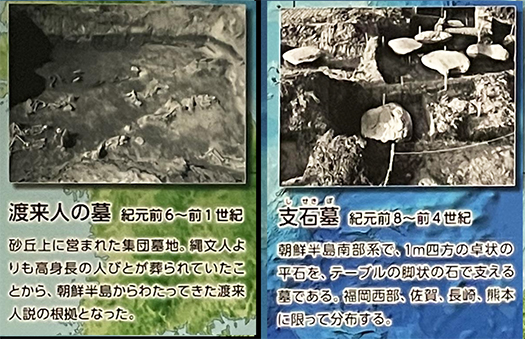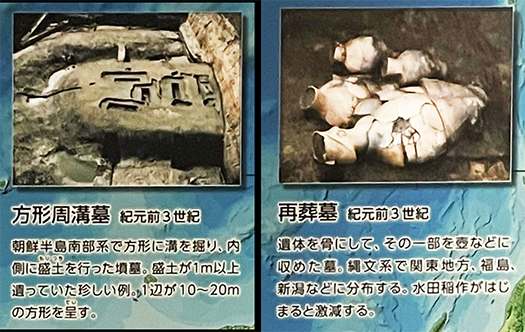



きのう見たように鉄という産業革命が弥生の世を決定づけたものだろう。
中国大陸で開発された製鉄技術が最初はその製品・利器が直接導入され
その後、製鉄原料が輸入されて現場で「鍛冶」加工された。
集団労働が基本である水田農耕においてはこの鉄器管理が最重要で
そこに支配という権力構造の高度化の根源的意味があった。
吉野ヶ里遺跡にその痕跡があるとされ、はるか後年の飛鳥宮でも
鍛冶工房跡が王権中枢の数百メートル範囲で発掘されている。
このことがその後の「日本史」の基軸的な動因と思える。
さてそういう社会の中で、先人たちの多くの死が積層していった。
弥生社会は紀元前10世紀ころから成立し近畿で「前方後円墳」が成立するまで
およそ1200年間、各地でさまざまな墓が作られた。
ひとの死はその時代相を表しひとびとの祈りの本質もうかがえる。
古い時代順に、全国の発掘例を上げてみたい。
●支石墓<紀元前8-紀元前4世紀〜福岡県志登支石墓群>
朝鮮半島南部系で1m四方の卓状の平石をテーブル脚状の石で支える墓。
福岡西部、佐賀、長崎、熊本に限って分布する。
●渡来人の墓<紀元前6−紀元前1世紀〜山口県土井ヶ浜遺跡>
砂丘上に営まれた集団墓地。縄文人より高身長の人びとが葬られていたことから
朝鮮半島から渡ってきた「渡来人」説の根拠となった。
●方形周溝墓<紀元前3世紀〜大阪府瓜生堂遺跡>
朝鮮半島南部系で方形に溝を掘り内側に盛り土を1m以上遣っている珍しいカタチ。
1辺が10-20mの方形を呈している。
●大型墳丘墓<紀元前3世紀〜大阪府加美遺跡>
26×15m、高さ3mと大型で墳丘内から23基の木棺が確認された。成人14基と
小児9基が見つかり、豊かな副葬品を持っていた。
●再葬墓<紀元前3世紀〜茨城県泉坂下遺跡>
遺体を骨にしてその一部を壷などに収めた墓。縄文系で関東、福島・新潟などに
分布する。水田農耕が始まると激減する。
●方形周溝墓<紀元前2世紀〜紀元前1世紀〜神奈川県歳勝土遺跡>
隣接の大塚遺跡と80mほど離れて墓道で繋がっていた。25基ほどが
見つかっているがもともと30基ほどあったと考えられている。
●甕棺墓<紀元前1世紀〜福岡県立岩遺跡>
棺専用に作られた高さ70cm以上の壷や甕で福岡、佐賀、長崎、熊本、大分、
鹿児島の一部に分布する。紀元前6世紀から紀元後3世紀まで作られる。
列島社会というものが在来の縄文系の人びとと
水田稲作とともに「東アジアのフロンティア」として移住してきた人びとの
混淆というカタチで社会形成されてきた様子がしずかに伝わってくる。
やがて墓制は古墳時代から仏教の導入という局面に進んでいく。
古墳とは権力者の象徴でありその後の寺院建築と対比されるもの。
そうするとこれらの墳墓のカタチとは建築的志向の基層ともいえる。
先人の思いを知ることは自分を知ることと同義なのだろう。合掌。
English version⬇
Death and Tombs in the Yayoi Period: The 37,000-Year History of the Japanese Archipelago – 36
The tombs are silent time capsules of the state of society. The tombs are a quiet time capsule of the state of society, from which the way of life of our ancestors and their way of living naturally emerge. The Tomb of the Dead
As we saw yesterday, the industrial revolution in the form of iron was probably the defining factor in the Yayoi period.
Iron manufacturing technology developed in mainland China was first introduced directly into Japan.
Later, ironmaking materials were imported and “forged” on site.
In rice paddy farming, which is based on collective labor, the management of iron tools was of paramount importance.
This was the fundamental meaning of the advancement of the power structure of domination.
It is said that there are traces of the ironworking at the Yoshinogari site, and even at the Asuka Palace, which was built much later, traces of ironworking have been found.
The remains of a blacksmith workshop have been excavated within a few hundred meters of the center of royal authority.
This seems to have been the key factor in the subsequent “history of Japan.
In such a society, the deaths of many of its predecessors were layered on top of each other.
The Yayoi society was established around the 10th century B.C., and for about 1,200 years, various graves were excavated in various locations until the “front-recessed circular mounds” were established in the Kinki region.
Various tombs were built in various places for approximately 1,200 years until the “front-recessed circle burial mounds” were established in the Kinki region.
The death of a person represents the phase of the time, and the nature of people’s prayers can also be seen.
The following are examples of tombs excavated throughout Japan in chronological order.
Stone Tomb <8th century B.C.-4th century B.C.E.> Shido Stone Tomb Group, Fukuoka Prefecture
A 1m square table-shaped flat stone supported by table-leg stones.
They are found only in western Fukuoka, Saga, Nagasaki, and Kumamoto.
Tomb of a visitor to Japan <6th century B.C.-1st century B.C.E.> Doigahama site, Yamaguchi Prefecture
A mass grave constructed on a sand dune. The fact that people taller than the Jomon were buried here suggests that they were “migrant” people from the Korean Peninsula.
The fact that people taller than the Jomon people were buried in these graves has become the basis for the theory that these people came to Japan from the Korean Peninsula.
Square ditch tombs (3rd century B.C.E. – Uryudo site, Osaka Prefecture)
This is an unusual shape of a tomb from the southern part of the Korean Peninsula, in which a square trench was dug and a fill of more than 1 m was placed inside the trench.
It is a square with one side measuring 10 to 20 meters.
Large mound tomb <3rd century B.C.E. – Kami Site, Osaka Prefecture
The mound is large, measuring 26 x 15 m and 3 m high. 23 wooden coffins were found in the mound. Fourteen adult coffins and nine child coffins were found.
The coffins were found to be rich in burial accessories.
Reburial Tomb <3rd century BC – Izumisakashita site, Ibaraki Prefecture>.
A grave in which the remains of a deceased person were reduced to bones and a portion of the bones were placed in an urn or other container. Jomon type, distributed in the Kanto region, Fukushima, Niigata, and other areas.
The graves were distributed in the Kanto region, Fukushima, Niigata, and other areas. The number of these tombs decreased drastically when rice paddy farming began.
Square ditch tombs (2nd century B.C.-1st century B.C.-Toshikatsuchi site, Kanagawa Prefecture)
About 25 graves were found, but it is thought that there were originally about 30.
It is thought that there were originally about 30 of these tombs.
Jar coffin tomb (1st century B.C. – Tateiwa site, Fukuoka Prefecture)
These are jars or pots more than 70 cm high made exclusively for coffins and are found in Fukuoka, Saga, Nagasaki, Kumamoto, Oita, and Kagoshima.
They are distributed in Fukuoka, Saga, Nagasaki, Kumamoto, Oita, and Kagoshima. They were made from the 6th century BC to the 3rd century AD.
The archipelago’s society is a combination of the native Jomon people
and those who migrated to the archipelago as the “frontier of East Asia” with rice cultivation in the paddy fields.
The mixture of native Jomon people and those who migrated to the archipelago as “the frontier of East Asia” along with paddy rice cultivation is quietly conveyed.
Eventually, the tomb system progressed from the Kofun period to the introduction of Buddhism.
Kofun tombs are symbols of power and are contrasted with the architecture of temples that followed.
In this sense, the shape of these tombs can be seen as an expression of architectural orientation.
Knowing the thoughts of our ancestors is probably synonymous with knowing ourselves. I bow my head in prayer.
Posted on 12月 6th, 2022 by 三木 奎吾
Filed under: 日本社会・文化研究, 歴史探訪







コメントを投稿
「※誹謗中傷や、悪意のある書き込み、営利目的などのコメントを防ぐために、投稿された全てのコメントは一時的に保留されますのでご了承ください。」
You must be logged in to post a comment.